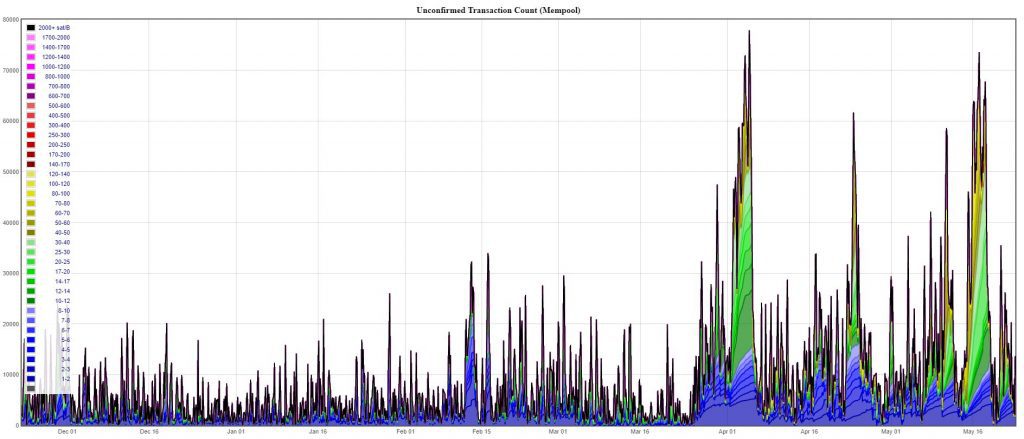As Fees Climb, Will Bitcoin Be Ready For Adoption?
It's time to reopen the scaling debate.

Share this article
With prices back on the upswing, bitcoin’s transaction count and fees have increased noticeably over the past few months. As more new users begin entering the market, it may be time for the BTC community to ask itself if the technology is truly ready for mass adoption.
While the Ethereum, Bitcoin Cash, and BSV communities have implemented or are actively discussing scaling protocols to reduce blockchain congestion, Bitcoin hasn’t had a major on-chain scaling development since the adoption of SegWit in August 2017. The lack of on-chain upgrades could become a use-case problem, creating bottlenecks for Bitcoin’s growth.
I See A Mempool Risin’
Bitcoin’s mempool – the gathering place for transactions, before miners enter them into the immutable ledger – has grown sharply in 2019.
At the same time, this month’s price action has also brought a sharp increase in transaction costs. Bitcoin’s median transaction fees are approaching $3.00, the highest level of the past year.

SegWit adoption has been sluggish. The protocol is intended to reduce transaction sizes, by separating them from their digital signatures. But almost two years since SegWit’s implementation, less than half of all bitcoin transactions deploy it.
The Lightning Network, an off-chain scaling solution, is small but growing. Currently it has over 36,000 channels, with total funds of over 1,000 BTC. There has been some debate about whether the bitcoin blockchain should rely on second layer channels to record transactions, despite the speed benefits of doing so.
Ethereum’s Doing It
Ethereum has been criticized as an inordinately slow network, with only 20 transactions per second. But developers seem to have gotten the message: Ethereum 2.0 promises to usher in a wave of changes, including the second-layer scaling solution, Plasma.
According to its creators, the Plasma protocol is an:
In addition to Plasma, the Ethereum community is already busy developing the first-layer scaling solution of sharding. This process splits the blockchain into separate sections, or shards, allowing groups of nodes to divide the labor of processing transactions.
With a $30 million war chest of funds from the Ethereum Foundation to work with, Ethereum is hoping to overcome its widely publicized scaling problems and take what they might regard as their rightful top place among platform blockchains.
Easier Said Than Done
Scaling distributed ledgers is difficult because of their decentralized nature. As Vitalik Buterin describes it, blockchain communities face a “scalability trilemma”:
Bitcoin Cash Proves That Breaking Up Is Hard to Do
Bitcoin cash has been faster to deploy upgrades, but they came at high costs. They implemented CTOR in November 2018 in order to scale up network speeds by reducing transaction complexity.
The debate was so heated that nChain and Coingeek threatened to fork from BCH. The Ayre-Wright side wanted to raise block sizes to hundreds of megabytes, while the ABC side preferred a more incremental approach to upgrading the chain.
The contentious hard fork that resulted produced a hash war, plummeting prices and immense antagonism between the parties, which remains today.
The larger bitcoin cash chain (BCH) recently implemented Schnorr signatures, shaving a theoretical 25 percent of heft off of transactions. The additional benefits of Schnorr signatures are security and privacy.
What Does All This Tell Us?
Layer 1 protocol upgrades, such as SegWit and Schnorr signatures, are more difficult to implement. The larger and more widespread the developer community is, the more chances there are for division and disagreement. But when they are agreed upon without contention, they have the ability to bring significant improvements to slow blockchains, edging them closer to real-world applicability.
But therein lies the nexus of the problem. As Buterin argued, scalability enhancements and decentralization can be mutually uneasy bedfellows. To the extent the blockchain revolution is about decentralization, expecting the rapid deployment of network upgrades is a bit like having your cake and eating it, too.
Distributed ledger technology promises to free humankind of its scarred history with democracy, an ideal which has often been co-opted (or turfed) by powerful elites and narrow interests. Given the balancing act DLT needs to perform between efficiency and decentralization, the scaling debate mirrors that same historical human experience.
Share this article

